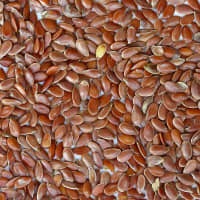Flaxseeds are from the Linum usitatissimum L. plant.
Flaxseeds occur in two basic varieties/colors: brown or yellow (golden linseeds).
Composition
Lignans
Flaxseeds have lignan contents several times higher than other dietary sources.[1]
Flaxseeds are principally the richest known source of lignans (9–30 mg/g (approximately 301 mg/100 g), with lignan production at 75–800 times that of cereals, legumes, other oil seeds, vegetables and fruit. The principal dietary lignan present in flaxseeds is secoisolariciresinol (2,3-bis (3-methoxy-4-hydroxybenzyl) butane-1,4-115 diol) which is stored as the conjugate SDG that occurs as a component of a linear ester-linked complex in the plant.[1:1]
Consumption
Whole flaxseeds are chemically stable, but ground flaxseed meal, because of oxidation, may go rancid when left exposed to air at room temperature in as little as one week.
Flaxseeds produce a vegetable oil known as flaxseed oil or linseed oil, which is one of the oldest commercial oils.
Title: The what and who of dietary lignans in human health: Special focus on prooxidant and antioxidant effects
Publication: Trends in Food Science & Technology
Date: October 2020
Archive Link
